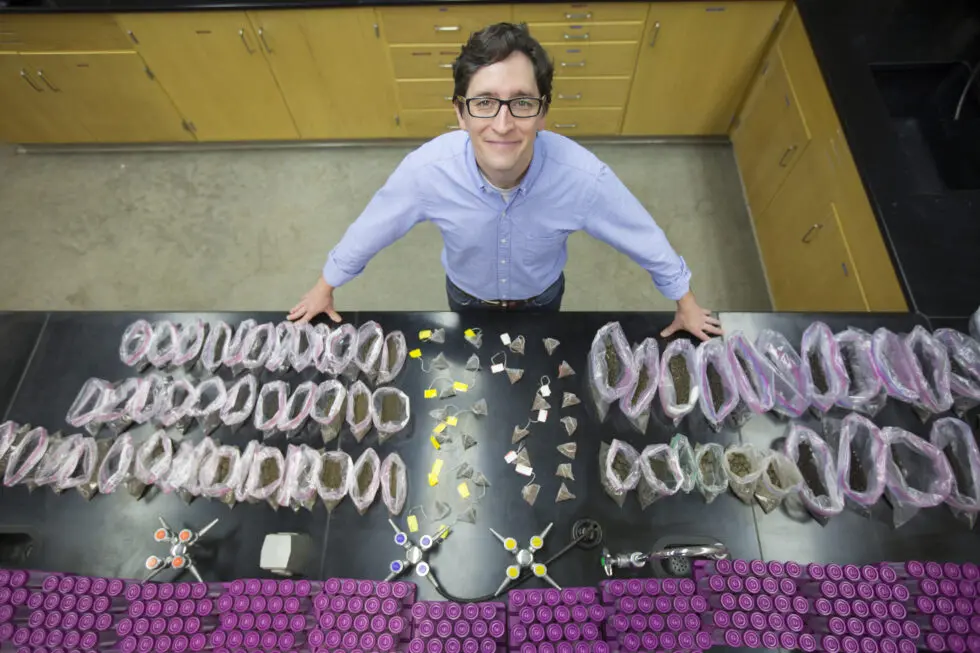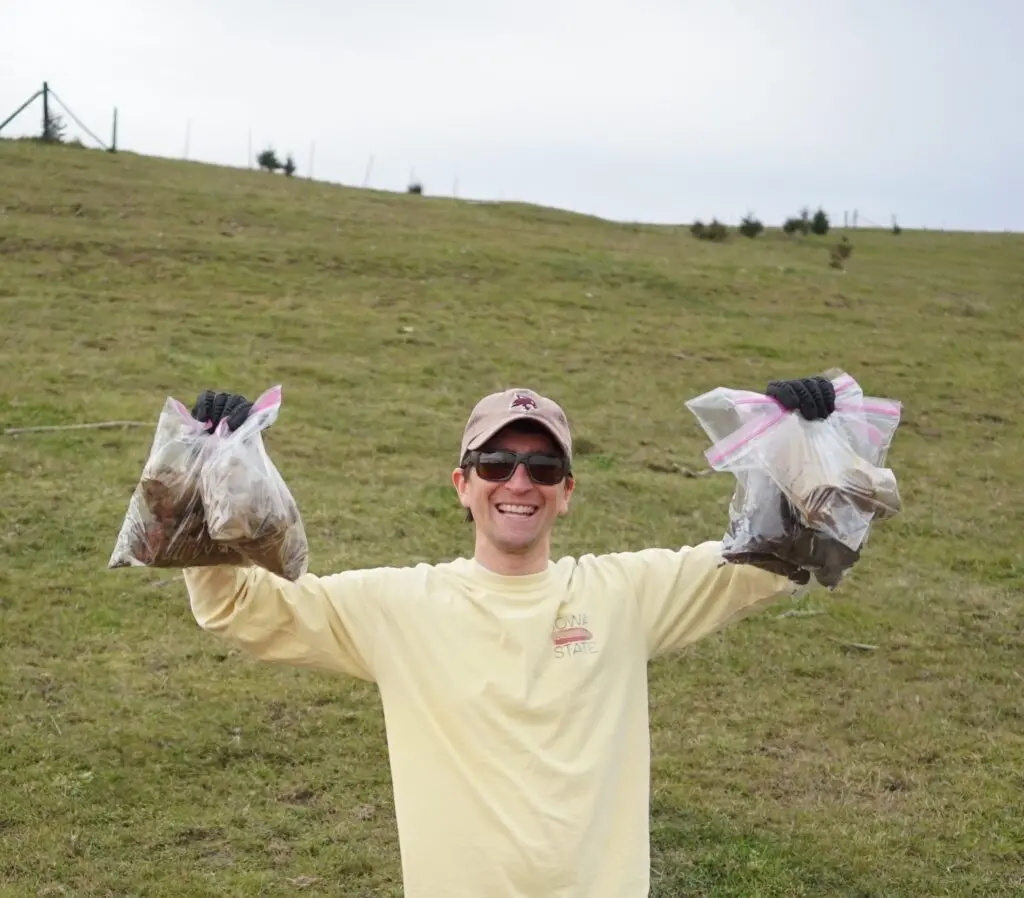
Iowa State University’s Marshall McDaniel wears lots of hats: soil scientist, student mentor, “mischief maker,” and even amateur musician. His latest role is an investigator for CABBI’s Sustainability Theme, which he joined a few months ago.
Originally from the Chicago suburbs, McDaniel earned his bachelor’s degree in environmental science at the University of Oklahoma. He pursued his interest in environmental research at the University of Illinois Urbana-Champaign, where he earned his master’s degree in Natural Resources & Environmental Sciences, then completed his Ph.D. in Soil Science and Biogeochemistry at Penn State University. Although he traveled to Australia for his postdoctoral work, McDaniel returned to the Midwest as an Assistant Professor of Agronomy at Iowa State and has worked there since.
In this Q&A with CABBI Communications Intern Kratika Tandon, McDaniel discusses his research in soil-plant interactions, his work outside of research, and hopes for his future with CABBI.
How did you come to be a part of CABBI?
I got involved with faculty at Iowa State who were already part of the CABBI program: Emily Heaton, Andy VanLoocke, and Adina Howe. And the three of them kind of roped me into some of their projects before I was officially part of CABBI. And then, as Emily Heaton moved back to the University of Illinois, it left a gap here at Iowa State. Andy and Adina asked me to join the team, and then I became more official.

Tell me about the work you do in the CABBI Sustainability Theme. What kind of research is your team working on?
My official title at Iowa State is “Soil-Plant Interactions.” I’ve got more experience as a soil scientist, but over the past couple of years, my lab has garnered more projects where we’re integrating both the plant and the soil aspect. We might be measuring root morphology, root biomass, or plant growth in relation to soil fertility. So, colloquially, the position is about how soils deliver ecosystem services, which are the processes that allow life to function on the planet. That includes sequestering carbon in soils, efficiently circulating nutrients to plants, storing water, and provisioning plant growth in general.
What does your day-to-day look like?
A lot of my day is spent in meetings and sending emails trying to fund what is essentially a small business. Now, to be a successful faculty in research, you have to manage a successful small business. You’re doing a lot of meetings and planning to acquire more funding so that you can keep people hired or hire new people to keep a project going. Some of my favorite parts of my job are mentoring students and just continuing to learn. In academia, one of the things that’s probably the most appealing is that we’re lifelong learners, and some of my favorite projects are those that are interdisciplinary.
Speaking of which, what is your favorite part of conducting research on soil-plant interactions?
I think one of the most exciting things is the versatility and how it’s different day-to-day. I could be out in the field collecting soil or plant samples, or I could be in the lab helping students out. And those are probably my favorite things to do. If I had more free time or I could clone myself, I’d be out in the field and maybe doing more bench work and learning more statistical analysis.
I read in your lab page that you introduce yourself as a “fearless leader and mischief maker.” How else might you describe yourself as a scientist?
I think sometimes I cause my students more of a headache than help, but I hope that I’ve been a good mentor to them, too. That’s one of the things I really strive for: to help propel my students into careers. I was the first in my family to get a four-year degree, let alone go to graduate school. I really strive to help students out who are underrepresented or who come from a family like mine and get them interested in research. I like having fun and talking science and reading papers with students and discussing current issues in our fields. That’s what makes my job really rewarding: mentoring students and having fun and propelling them to careers that they’re really happy with as well.
What do you find most challenging about your work?
I think it’s just juggling all the different aspects of the job and running a small business, essentially, and then also balancing that with teaching duties. I spend a lot of my time preparing for classes and teaching, mentoring, and advising undergraduate students in our department. I also do a lot of service to both the department and the college level; being on a scholarship committee takes up a lot of time. It’s all rewarding, but juggling all that stuff is challenging — and it means I have to be as efficient as possible.
What is the main thing that you hope for readers to take away from your research?
Our research has a two-pronged approach: a strong basic and applied research angle. I really like to do research that plows the way forward on the frontier of soil-plant sciences — in other words, conducting basic science that contributes to our overall knowledge of how soils and plants work. But I also enjoy conducting applied research that is relevant to those that might be using our findings. So, this might be growers or agronomists or other people who are out boots-on-the-ground doing some of these management practices that can make our agriculture systems more sustainable and regenerative.
What are you looking forward to through your collaboration with CABBI, how will this help your research, and how do you think your research will contribute to the work done by CABBI’s Sustainability team?
I’m just excited to work with a fantastic team of folks at CABBI and a neat network of long-term experiments. So, continuing that work but also building new collaborations. I hope I can contribute my expertise and knowledge to the team and improve the sustainability of our agriculture systems.
What do you hope for in the future of agroecosystem sustainability, and how is your team working toward this?
One angle of sustainability that I’ll mention is nitrogen cycling and leakiness. So, we know that the kind of “business as usual” way of managing agricultural systems right now is very leaky with regards to nitrogen, so it leaches to groundwater or to surface waters — usually in the form of nitrate — and can cause water pollution issues if there’s too much. And then we can also have nitrogen loss as greenhouse gas emissions that can contribute to climate change. Nitrous oxide, for example, is a more potent greenhouse gas than carbon dioxide. So, a lot of the projects in my research group (including my collaborations and projects with CABBI), are looking at how we can manage agroecosystems to cycle nitrogen more efficiently and reduce its loss as greenhouse gas or water pollutant.
What sorts of projects do you hope to work on in the future?
I’m really excited about a few CABBI projects. In one project, we’re looking at using a cover crop with sorghum, and in another, we’re furthering our understanding of what’s going on with the soil under miscanthus plants. We found that miscanthus increased the soil’s water holding capacity by 15% compared to corn. Or in other words, it increased the amount of water that the soil particles can hold — think of a sponge’s ability to hold water. This small, but significant increase in water holding capacity could mean that miscanthus could reduce run-off, reduce downstream flooding, and even provide extra water during dry times (like July in the Midwest). We’re exploring the underlying mechanisms — how and why does miscanthus increase soil water holding capacity? We already know it has something to do with the way miscanthus is restructuring the soil particles and changing the soil pore space. A new Ph.D. student is going to be measuring and monitoring how miscanthus root and the biology of the soil are altering soil structure to increase pore space.
Finally, what are some of your hobbies, interests, passions, anything outside of work?
When I do have free time, I’m into card games and board games — especially poker or Settlers of Catan — those are some of my favorites to play with friends and family. And then I also am an amateur musician. I can play a little bit of guitar and electric bass. And my friend Emily Heaton gave me a drum set that her family was no longer using, so I’ve been trying to learn drums in my spare time over the past couple of years.